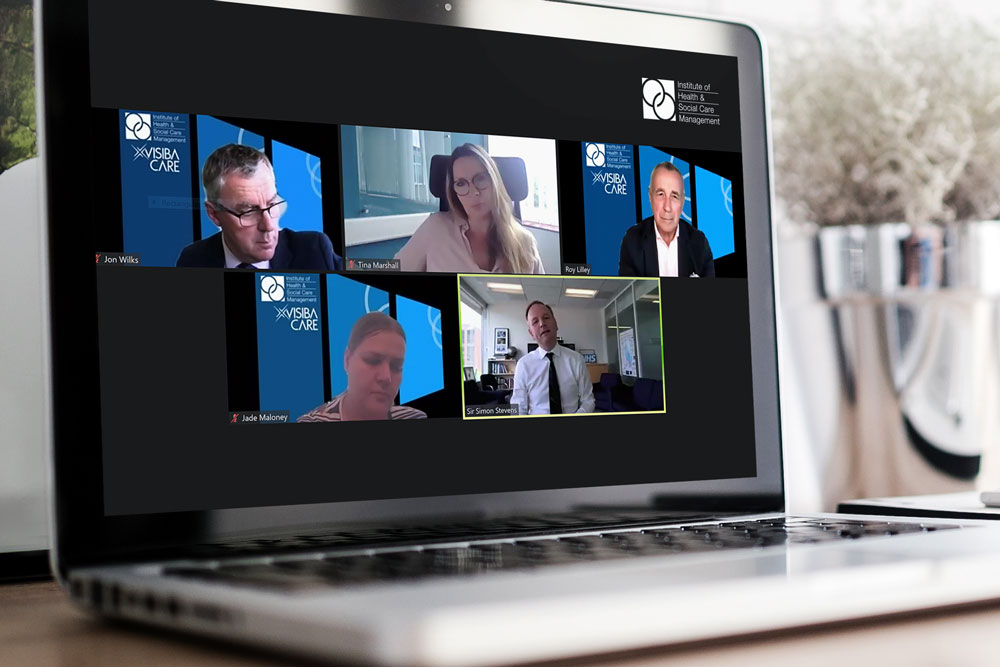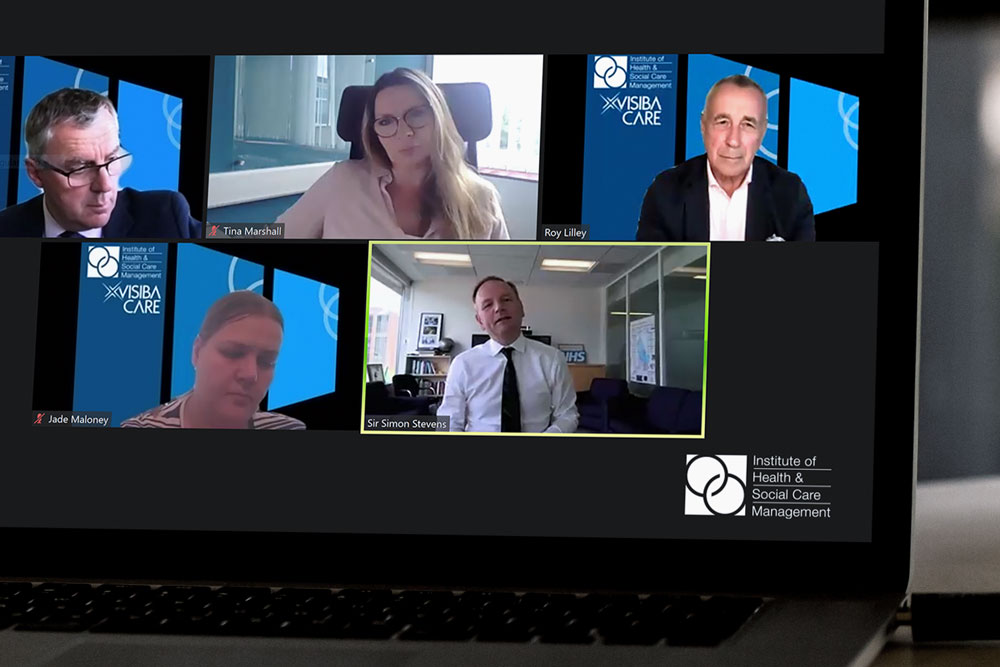The outgoing chief executive of NHS England spoke to Roy Lilley in his regular interview slot for the Institute of Health and Social Care Management. The wide-ranging discussion covered the Covid-19 pandemic, the NHS Long Term Plan, whether Sir Simon is going to the Lords to sort-out social care, what advice he has for his successor. Lyn Whitfield reports.
Sir Simon Stevens, who leaves NHS England on 31 July after seven years as its chief executive, has had a nice line for interviewees asking him what advice he will pass on to his successor. He has been telling the story of his first day out of the NHS graduate training programme, when he arrived to take over a mental health facility in the North East of England.
“I came across a group of people on the drive, so I stopped and said: ‘hello, I’m Simon, and what are you doing?’,” he told Roy Lilley, the veteran commentator who leads the Institute for Health and Social Care Management’s Health Chat. “And they said: ‘scattering the ashes of your predecessor’.” Beat that for a hand over.
The most influential figure since Nye Bevan?
Sir Simon has had an extraordinary impact on the NHS over twenty years and two very different governments. After the 1997 general election, which swept New Labour to power, he became a special advisor to the very old Labour health secretary, Frank Dobson.
He stayed on to help Dobson’s successor, Alan Milburn, draft ‘The NHS Plan’ in 2000, before moving on to Downing Street. After a stint in the US with health management organisation United Health, he returned to take over an NHS traumatised by Andrew Lansley’s 2012 reforms.
In retrospect, the ‘Liberating the NHS’ reforms proved to be the last, doomed attempt to ginger up the ‘internal market’. The NHS was out of New Labour’s money, facing rising demand from an ageing and increasingly unequal society, and struggling to pick up the pieces from a broken social care system.
It needed a new approach, and Sir Simon provided one with the ‘Five Year Forward View’ and its successor the ‘NHS Long Term Plan’. To fund their vision of controlling demand and improving efficiency by introducing population health management and integrated care, he also worked with health secretary Jeremy Hunt to persuade Number 10 and the Treasury to give the NHS a 70th “birthday present”. The funding they secured might not have been enough; but it was a lot better than any other public service got during the post-2008 crash years of ‘austerity’. With the plan and the first half of its funding in place, and Hunt dislodged by the political fall-out from Brexit, Sir Simon was expected to move on. Then Covid-19 hit.
Covid-19, the NHS and digital health
Lilley asked about the earliest days of the crisis, when NHS England put the health service on an emergency footing before the World Health Organisation declared a pandemic. Sir Simon implied they had been surreal. “We had to mobilise the NHS for what might be coming, but at the same time we were trying to do things like find space for people returning from Wuhan,” he said.
“So, on the one hand we were holding crisis briefings, and on the other I was on the phone to the chief executive of Arrowe Park Hospital saying that if he needed things to make the accommodation for them ok – if he needed toys, or whatever – he could do it and put it on the NHS England credit card.”
By March 2020, though, things were: “Very worrying. The numbers were going up all the time, and nobody knew where they would cap out. People were wonderful, and they responded with agility, but there were some scary times.”
One of the features of the early days of the crisis, away from the reconfigured hospitals and packed intensive care units, was the rapid deployment of remote working and virtual clinic and consultation technologies. Lilley asked if they might remain.
“If anything good has come out of this, it is the acceleration of the adoption of digital solutions,” he suggested. “But how much of it will stick? My worry is that unless you change the tariff, and make it worth while for hospitals and GPs to stick with it, we will slip back to doing what we have always done.”
Sir Simon agreed the “the jury is still out” on whether there is “no going back” on digital health. But he didn’t want to see NHS England laying down a model for digital first. “A lot of the things that people did during the pandemic are things that they want to do going forward, so it will find its own level,” he said.
“On the much-discussed GP appointment front, we started at around 90% face to face and at the peak of the pandemic we flipped that on its head and now it is about half and half; but I think it would be wrong to put out a target saying: ‘the right number is x’.
“Being able to sit down with a GP or a nurse is the foundation of the health service, so we need to offer alternatives that make sense from a personal and a clinical point of view.”
The pandemic legacy: waiting lists at 5 million and rising
Lilley suggested a “more unwelcome legacy of Covid” is the huge backlog of elective care that the NHS now faces, with the waiting list at 5 million and rising. “It really is a mountain to climb, and I do not see a plan to fix it,” he said. Sir Simon said that if there wasn’t a plan, the outlines of one were becoming clearer.
“Going into the start of the financial year, there were three known unknowns,” he said. “How much Covid we would have to cope with, and how many patients there would be. The impact of ongoing infection control measures on the number of procedures that [trusts] can do.
“And how many people who did not come forward over the past 18 months will come forward now. As we move into the second quarter of the year, the level of uncertainty is levelling somewhat, and I think that over the next 30 months, the NHS will need to do around 120% of its normal, elective activity to get through it.
“The plan that will be put together this autumn will look at the capacity to do that. Generally, though, the NHS has done a great job of coming back up – we are at about 93% of normal – and we have vanguards looking at how to do a fifth more than normal. So it’s tough, but it’s feasible.”
However, he noted, with another comprehensive spending review coming up, “the government will have choices to make” about whether and how it wants to fund this activity.
The one that got away: social care
Lilley pointed out that the government has other, tough choices to make on social care. One of New Labour’s first initiatives was to set up the last Royal Commission to investigate the issue. But its members failed to agree on the fairest way to fund care for the growing number of young adults and elderly people who need it.
Since then, reports and reviews have come and gone. Councils have tightened the criteria for who can receive care to the point where many individuals miss out. An over-leveraged care home sector has seen rates cut to the point where much of it is on the point of going bust.
Yet voters still complain that elderly relatives have to sell their houses and see their legacies run down to £23,000 to pay for what little means-tested support is available. In 2017, former prime minister Theresa May promised that a social care green paper would be drawn up, and two-years later her successor Boris Johnson claimed he had a plan to “fix the social care crisis once and for all.”
Yet, two-years on, no plan has emerged, and Johnson and his new health and social care secretary, Sajid Javid, are saying only that “the outlines of a solution” might emerge “quite soon”. Sir Simon said that when it does, it should aim to increase the “quantity and quality” of care delivered – and not just who pays for what is available now. “We have to change the way social care delivers care – more personalisation, fewer binary choices – and we need to sort out the workforce,” he said. “Then we need to work out the bit that exercises politicians, which is people selling their houses to pay for long term care. There is a lot to it, but the political stars may be starting to align around it.”
Baron Stevens of Birmingham
Social care is the one, big element of the NHS Long Term Plan that has yet to be tackled at all. Other changes are in hand, even if they have been delayed by Covid, and it is far from clear whether the spending review will fund them.
A Health and Care Bill is working its way through Parliament to formally create a single organisation to run the health service out of the complex web of NHS England, NHS Improvement, and other agencies that exist on paper, if not on the ground. And the Bill will put integrated care systems on a statutory footing.
The arrival of the Bill has caused something of a lull in planning and commissioning as ICSs work out their boundaries, who needs to sit on the ICS NHS Body board and the wider stakeholder board that is supposed to work with local councils, and what ‘place’ based delegation is supposed to mean.
Sir Simon seemed relaxed about progress, telling Lilley that a “one size fits all” model would not work across England and it is important to be “pragmatic” and to let ICSs “evolve.” But then, it’s not his problem anymore.
He is heading for the Lords, as Baron Stevens of Birmingham, but he told Lilley that he won’t be spending his time sorting out the more contentious elements of the Bill, like extra powers for ministers, or grappling with social care.
“I have been talking to lots of people about this transition and they all say: ‘don’t leap out of the frying pan into the fire’,” he said. “I will take stock, before deciding where I have something to contribute.” In practice, though, he has been handing out three, small pieces of advice for his successor who has now been revealed as his chief operating officer, Amanda Pritchard.
They are to “listen hard” – particularly to people you don’t agree with – to “keep an eye on your north star” – which in his case has been the mantra to “think like a patient and act like a tax-payer” – and to “keep the NHS in conversations that matter” – which includes conversations about funding, even if that causes some “discomfort” to politicians. At the end of his interview, Lilley wished Sir Simon well. “The NHS has been lucky to have you,” he said. It’s hard to disagree. He’ll certainly be a very tough act to follow.




